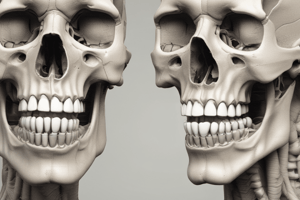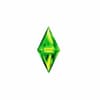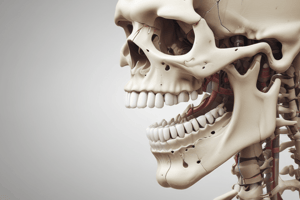Podcast
Questions and Answers
Quel est le rôle des otolithes dans l'oreille?
Quel est le rôle des otolithes dans l'oreille?
- Améliorer le goût et l'audition
- Maintenir l'équilibre dans toutes les directions (correct)
- Contribuer à la mastication
- Aider à la respiration
Quand commence à se former le crâne embryonnaire?
Quand commence à se former le crâne embryonnaire?
- Au 4e mois embryonnaire
- Entre le 2e et le 3e mois embryonnaire (correct)
- Entre le 3e et le 4e mois embryonnaire
- Au 1er mois embryonnaire
Quels éléments font partie du système masticatoire?
Quels éléments font partie du système masticatoire?
- Humerus et radius
- Cerveau et moelle épinière
- Huesos, dientes, articulación, ligamentos, músculos et nervios (correct)
- Foie et reins
Quelle fonction est associée à la 2e couche de la membrane otorhinolaryngologique (ORL)?
Quelle fonction est associée à la 2e couche de la membrane otorhinolaryngologique (ORL)?
Quelles sont les fonctions principales de l'articulation temporomandibulaire (ATM)?
Quelles sont les fonctions principales de l'articulation temporomandibulaire (ATM)?
Qu'est-ce qui manda et amortit dans tous les os?
Qu'est-ce qui manda et amortit dans tous les os?
Quelle est la fonction de la hoz del cerebro?
Quelle est la fonction de la hoz del cerebro?
Quelle est la principale composante de la duramadre et des méninges?
Quelle est la principale composante de la duramadre et des méninges?
Qu'est-ce qui osifie peu à peu la partie membranosa des os du crâne?
Qu'est-ce qui osifie peu à peu la partie membranosa des os du crâne?
Quel élément est essentiel pour la relaxation des muscles?
Quel élément est essentiel pour la relaxation des muscles?
¿Cuál es la función de los otolitos en el oído?
¿Cuál es la función de los otolitos en el oído?
¿Cuál es la principal función del Sistema Masticatorio?
¿Cuál es la principal función del Sistema Masticatorio?
¿En qué mes embrionario comienza a formarse el cráneo?
¿En qué mes embrionario comienza a formarse el cráneo?
¿Dónde se encuentra la placa basilar responsable del inicio de la formación del cráneo?
¿Dónde se encuentra la placa basilar responsable del inicio de la formación del cráneo?
¿Cuál es la función de la capa mucosa en el sistema otorrinolaringológico (ORL)?
¿Cuál es la función de la capa mucosa en el sistema otorrinolaringológico (ORL)?
¿Cuál es la función de la parte cartilaginosa en todos los huesos?
¿Cuál es la función de la parte cartilaginosa en todos los huesos?
¿Cuál es la función de la parte membranosa en todos los huesos?
¿Cuál es la función de la parte membranosa en todos los huesos?
¿Cuál es la relación entre el occipital y el sacro en una persona de perfil?
¿Cuál es la relación entre el occipital y el sacro en una persona de perfil?
¿Qué relación tiene la duramadre con el cuerpo humano?
¿Qué relación tiene la duramadre con el cuerpo humano?
¿Cuál es uno de los elementos que proporciona elasticidad al cráneo?
¿Cuál es uno de los elementos que proporciona elasticidad al cráneo?
Flashcards
Otolith Function
Otolith Function
Otoliths, small calcium carbonate crystals in the inner ear, play a crucial role in maintaining balance by sensing head movements and gravitational pull.
Cranial Formation
Cranial Formation
The embryonic skull begins to form between the second and third month of pregnancy.
Masticatory System Components
Masticatory System Components
The masticatory system, responsible for chewing, comprises bones, teeth, joints, ligaments, muscles, and nerves.
ORL Layer Function
ORL Layer Function
Signup and view all the flashcards
Temporomandibular Joint (TMJ) Functions
Temporomandibular Joint (TMJ) Functions
Signup and view all the flashcards
Cartilage Function in Bones
Cartilage Function in Bones
Signup and view all the flashcards
Cerebral Falx Function
Cerebral Falx Function
Signup and view all the flashcards
Dura Mater Composition
Dura Mater Composition
Signup and view all the flashcards
Cranial Bone Ossification
Cranial Bone Ossification
Signup and view all the flashcards
Magnesium's Role in Muscle Relaxation
Magnesium's Role in Muscle Relaxation
Signup and view all the flashcards
Otolith Balance
Otolith Balance
Signup and view all the flashcards
Masticatory System Function
Masticatory System Function
Signup and view all the flashcards
Cranial Formation Timeline
Cranial Formation Timeline
Signup and view all the flashcards
Basilar Plate Location
Basilar Plate Location
Signup and view all the flashcards
Mucosal Layer Function in ORL
Mucosal Layer Function in ORL
Signup and view all the flashcards
Cartilaginous Part in Bones
Cartilaginous Part in Bones
Signup and view all the flashcards
Membranous Part in Bones
Membranous Part in Bones
Signup and view all the flashcards
Occipital-Sacral Relationship
Occipital-Sacral Relationship
Signup and view all the flashcards
Dura Mater's Connection
Dura Mater's Connection
Signup and view all the flashcards
Cranial Elasticity Factors
Cranial Elasticity Factors
Signup and view all the flashcards





